Travel: Taiwan's night market
Posted:
10/21/2012 03:41:34 PM PDT
Updated:
10/21/2012 03:51:09 PM PDT
Visitors
to this vibrant democracy - known for its semiconductors and tech
gadgetry - can be mesmerized by Taipei's swarming motorbikes, natural
scenery along coastal beaches and mountains full of hiking trails.
There is also Taipei 101, one of the world's tallest buildings, which offers high-end shopping and dizzying high-level views. And the National Palace Museum, which displays some of the most important Chinese artifacts found anywhere.
But there are also Taiwan's night markets, among the best-kept secrets in the country.
As the sun goes down over Taiwan, the streets of this densely populated island come alive as thousands of people descend on streets and alleyways for some of the best and cheapest thrills one can find in Asia. The night markets serve up items ranging from tasty treats to inexpensive belts and sandals.
Sure, there are similar street scenes across the continent, from Cambodia to China. In Taiwan, however, night markets are a cherished cultural phenomenon that embraces traditions while remaining contemporary with quick-stepping, fashionably dressed young people who flood them.
Plunging into one of these body-bumping bazaars is a senses-awakening experience - wafting smells of good food, neon lights that dazzle like disco strobes, the singsong sales pitches of hawkers with bullhorns competing with throbbing techno music. This cacophony of street-side capitalism can last well past midnight.
As afternoon wanes, city streets are transformed into a highly festive nocturnal world aglow with charcoal fires and electronic billboards. A river of restless young Taiwanese flows through a warren of lanes filled with portable stands. They shop for Nike shoes, electric razors and even puppies. Vendors blend fruit and sugarcane drinks. Chicken and squid sizzle on grills.
Some night markets have foot massage parlors; others, snake restaurants.
In Taipei, about 20 night markets occur every day in addition to "floating" night markets, open occasionally or on fixed evenings, such as Saturdays, explained Lula Han, an expert on Taiwanese culture. There are as many as 100 major night markets across the island, she added.
"Every town, every city has two or three night markets," she said.
They are more than a place to pick up a pair of cheap sunglasses or grab a watermelon drink. For Taiwanese, they are equivalent to the corner pub where they meet friends and grab bites of handmade delicacies from curbside cooks.
Indeed, what really draws the jostling hordes is the xiaochi, or "small eats." In Taiwan, eating literally is a religious experience. That's because night markets initially sprang up around the
many
Buddhist temples in Taiwan, Han said. The Keelung market developed
around Dianji Temple, which is more than a century old, to meet the
eating needs of the faithful.
"We always say, when you worship God in the temple, you worship
your body, your temple," Han said as we eagerly made our way to one of
the oldest night markets in northern Taiwan, in the harbor city of
Keelung, on a misty spring evening. "After you give food to the god in
the temple, you give food to yourself. So the food stalls originated
with the temples."
These days, just as many Taiwanese visit the alleyways lined with food stalls as they do the temple to burn incense in the name of good fortune.
Even for non-Buddhists, the temples can offer
relief: They frequently are the easiest place to find a bathroom in a night market.
The Keelung night market, near the Keelung train station, is one
of the more traditional street markets in Taiwan. It has a neighborly
feel to it - couples with young children stroll past the food stalls,
students in their school uniforms cluster around an arcade. Its
proximity to the harbor is reflected in the plethora of fresh seafood
dishes. There is plenty of sushi and other Japanese-influenced food,
harking back to the early 20th century, when Taiwan was ruled by Japan.
"Every time I come here, I think that my stomach is too small," Han said as we scanned scores of stalls selling everything from barbecued seafood to shaved-ice peanut desserts.
One can feast all night for as little as $4 to $10. It's not unusual to see a wealthy business executive in a suit and a customer of much less means sitting side by side on a wooden bench or on squat plastic stools to tuck into a bowl of rice noodles, purchased for a pittance.
What makes the food so appetizing is that the lightly pan-fried cabbage buns or oyster omelets smothered in soy and chili sauces have been made and sold in night markets by the same families for generations, explained Han, who once debated getting an apartment in Keelung simply so she could be in walking distance of its fabled night market.
In Taipei, one doesn't have to go out at night to enjoy night-market culture. Some day markets stay open into the evening. One of the most famous is the Dihua Street Market, a historic narrow brick lane surrounded by a mix of building architecture, from China's Fujian Province to Baroque and contemporary, located in the western part of this city of 2.6 million residents. It's a great place to buy Chinese medicine, bolts of cloth and lots of edible goodies.
A friend and I perused the dried-food stores lining the street late one afternoon. Merchants sold dried blueberries, mullet, green-tea pumpkin seeds and more. During the Lunar New Year, the area draws massive crowds who buy special holiday treats such as chewy candies and smoked duck.
As often is the case, whenever there is an abundance of good food around, a temple is not far away. In this case, the Hsiahai Cheng Huang Temple is just around the corner. The relatively small temple attracts many young people seeking advice and help in finding love.
The dried-food snacks served to awaken our appetite for another night market. This time we made our way to Shilin Night Market, the city's most famous, located near the Cicheng Temple, a subway station and a number of schools. It's something of an all-season night market: It has food stalls in alleyways as well as in an enclosed area, making it waterproof when it rains.
As the sky was darkening, pushcart vendors made their way to the area.
It doesn't take a food reviewer to find the best eats here: Just look for the long lines.
There is also Taipei 101, one of the world's tallest buildings, which offers high-end shopping and dizzying high-level views. And the National Palace Museum, which displays some of the most important Chinese artifacts found anywhere.
But there are also Taiwan's night markets, among the best-kept secrets in the country.
As the sun goes down over Taiwan, the streets of this densely populated island come alive as thousands of people descend on streets and alleyways for some of the best and cheapest thrills one can find in Asia. The night markets serve up items ranging from tasty treats to inexpensive belts and sandals.
Sure, there are similar street scenes across the continent, from Cambodia to China. In Taiwan, however, night markets are a cherished cultural phenomenon that embraces traditions while remaining contemporary with quick-stepping, fashionably dressed young people who flood them.
Plunging into one of these body-bumping bazaars is a senses-awakening experience - wafting smells of good food, neon lights that dazzle like disco strobes, the singsong sales pitches of hawkers with bullhorns competing with throbbing techno music. This cacophony of street-side capitalism can last well past midnight.
As afternoon wanes, city streets are transformed into a highly festive nocturnal world aglow with charcoal fires and electronic billboards. A river of restless young Taiwanese flows through a warren of lanes filled with portable stands. They shop for Nike shoes, electric razors and even puppies. Vendors blend fruit and sugarcane drinks. Chicken and squid sizzle on grills.
Some night markets have foot massage parlors; others, snake restaurants.
In Taipei, about 20 night markets occur every day in addition to "floating" night markets, open occasionally or on fixed evenings, such as Saturdays, explained Lula Han, an expert on Taiwanese culture. There are as many as 100 major night markets across the island, she added.
"Every town, every city has two or three night markets," she said.
They are more than a place to pick up a pair of cheap sunglasses or grab a watermelon drink. For Taiwanese, they are equivalent to the corner pub where they meet friends and grab bites of handmade delicacies from curbside cooks.
Indeed, what really draws the jostling hordes is the xiaochi, or "small eats." In Taiwan, eating literally is a religious experience. That's because night markets initially sprang up around the
These days, just as many Taiwanese visit the alleyways lined with food stalls as they do the temple to burn incense in the name of good fortune.
Even for non-Buddhists, the temples can offer
IF YOU GO
Getting there: EVA Airways (evaair.com) and China Airlines (china-airlines.com) offer flights to Taiwan Taoyuan International Airport.
When to go: Fall, winter and early spring are cooler seasons in Taiwan. Summers are hot and humid.
Staying there: There is an abundance of hotels with varying price ranges in Taipei.
Less than $100: Forte Orange Business Hotel (Kaifeng), No. 41, Section 1, Kai-Feng Street, phone 886-2-2388-1523.
Midrange: Landis Taipei, 41 Min Chuan East Road, phone 886-2-2597-1234l; Novotel, 1-1 Terminal South Road, Taoyuan County, Dayuan Township, phone 886-3-398-0888. (This hotel has a great gym that's open 24/7.)
High end: Grand Formosa Regent, No. 3, Lane 39, Section 2, ZhongShan North Road, phone 886-2-2523-8000.
When to go: Fall, winter and early spring are cooler seasons in Taiwan. Summers are hot and humid.
Staying there: There is an abundance of hotels with varying price ranges in Taipei.
Less than $100: Forte Orange Business Hotel (Kaifeng), No. 41, Section 1, Kai-Feng Street, phone 886-2-2388-1523.
Midrange: Landis Taipei, 41 Min Chuan East Road, phone 886-2-2597-1234l; Novotel, 1-1 Terminal South Road, Taoyuan County, Dayuan Township, phone 886-3-398-0888. (This hotel has a great gym that's open 24/7.)
High end: Grand Formosa Regent, No. 3, Lane 39, Section 2, ZhongShan North Road, phone 886-2-2523-8000.
"Every time I come here, I think that my stomach is too small," Han said as we scanned scores of stalls selling everything from barbecued seafood to shaved-ice peanut desserts.
One can feast all night for as little as $4 to $10. It's not unusual to see a wealthy business executive in a suit and a customer of much less means sitting side by side on a wooden bench or on squat plastic stools to tuck into a bowl of rice noodles, purchased for a pittance.
What makes the food so appetizing is that the lightly pan-fried cabbage buns or oyster omelets smothered in soy and chili sauces have been made and sold in night markets by the same families for generations, explained Han, who once debated getting an apartment in Keelung simply so she could be in walking distance of its fabled night market.
In Taipei, one doesn't have to go out at night to enjoy night-market culture. Some day markets stay open into the evening. One of the most famous is the Dihua Street Market, a historic narrow brick lane surrounded by a mix of building architecture, from China's Fujian Province to Baroque and contemporary, located in the western part of this city of 2.6 million residents. It's a great place to buy Chinese medicine, bolts of cloth and lots of edible goodies.
A friend and I perused the dried-food stores lining the street late one afternoon. Merchants sold dried blueberries, mullet, green-tea pumpkin seeds and more. During the Lunar New Year, the area draws massive crowds who buy special holiday treats such as chewy candies and smoked duck.
As often is the case, whenever there is an abundance of good food around, a temple is not far away. In this case, the Hsiahai Cheng Huang Temple is just around the corner. The relatively small temple attracts many young people seeking advice and help in finding love.
The dried-food snacks served to awaken our appetite for another night market. This time we made our way to Shilin Night Market, the city's most famous, located near the Cicheng Temple, a subway station and a number of schools. It's something of an all-season night market: It has food stalls in alleyways as well as in an enclosed area, making it waterproof when it rains.
As the sky was darkening, pushcart vendors made their way to the area.
It doesn't take a food reviewer to find the best eats here: Just look for the long lines.
Taiwan's fabled night markets
Posted:
10/11/2012 03:00:00 PM PDT
Updated:
10/11/2012 03:27:43 PM PDT
4 of 25
Taiwan's night markets
The entrance to Kee Long Miao Kou night market, in Taipei, Taiwan on Monday, April 16, 2012. (LiPo Ching/Staff)
TAIPEI,
Taiwan -- Visitors to this vibrant democracy -- known for its
semiconductors and tech gadgetry -- can be mesmerized by Taipei's
swarming motorbikes, natural scenery along coastal beaches and mountains
full of hiking trails. There is Taipei 101, one of the world's tallest
buildings, which offers high-end shopping and dizzying high-level views.
The National Palace Museum displays some of the most important Chinese
artifacts found anywhere.
Taiwan's night markets, though, are among the best-kept secrets in the country.As the sun goes down over Taiwan, the streets of this densely populated island come alive as thousands of people descend on streets and alleyways for some of the best and cheapest thrills one can find in Asia. The night markets serve up everything from tasty treats to inexpensive belts and sandals.
Sure, there are similar street scenes across the continent, from Cambodia to China. In Taiwan, however, night markets are a cherished cultural phenomenon that embraces past traditions while remaining contemporary with quick-stepping, fashionably dressed young people who flood them.
Plunging into one of these body-bumping bazaars is a senses-awakening experience -- wafting smells of good food, neon lights that dazzle like disco strobes, the singsong sales pitches of hawkers with bullhorns competing with throbbing techno music. This cacophony of street-side capitalism can last well past midnight.
As afternoon wanes,
Advertisement
Like the corner pub
Some night markets have foot massage parlors; others, snake restaurants.
In
Taipei, about 20 night markets occur every day in addition to
"floating" night markets, open occasionally or on fixed evenings, such
as Saturdays, explained Lula Han, an expert on Taiwanese culture. There
are as many as 100 major night markets across the island, she added.
"Every town, every city has two or three night markets," she said.They are more than a place to pick up a pair of cheap sunglasses or grab a watermelon drink. For Taiwanese, they are equivalent to the corner pub where they meet friends and grab bites of handmade delicacies from curbside cooks.
Indeed, what really draws the jostling hordes is the xiaochi, or "small eats." In Taiwan, eating literally is a religious experience. That's because night markets initially sprang up around the many Buddhist temples in Taiwan, Han said. The Keelung market developed around Dianji Temple, which is more than a century old, to meet the eating needs of the faithful.
"We always say, when you worship God in the temple, you worship your body, your temple," Han said as we eagerly made our way to one of the oldest night markets in northern Taiwan, in the harbor city of Keelung, on a misty spring evening. "After you give food to the god in the temple, you give food to yourself. So the food stalls originated with the temples."
Religious devotion never tasted so good.
These days, just as many Taiwanese visit the alleyways lined with food stalls as they do the temple to burn incense in the name of good fortune. Even for non-Buddhists, the temples can offer relief: They frequently are the easiest place to find a bathroom in a night market.
The Keelung night market, located near the Keelung train station, is one of the more traditional street markets in Taiwan. It has a neighborly feel to it -- couples with young children stroll past the food stalls, students in their school uniforms cluster around an arcade. Its proximity to the harbor is reflected in the plethora of fresh seafood dishes. There is plenty of sushi and other Japanese-influenced food, harking back to the early 20th century, when Taiwan was ruled by Japan.
"Every time I come here, I think that my stomach is too small," Han said as we scanned scores of stalls selling everything from barbecued seafood to shaved-ice peanut desserts.
A low-cost feast
One
can feast all night for as little as $4 to $10. It's not unusual to see
a wealthy business executive in a suit and a customer of much less
means sitting side by side on a wooden bench or on squat plastic stools
to tuck into a bowl of rice noodles, purchased for a pittance.
What
makes the food so appetizing is that the lightly pan-fried cabbage buns
or oyster omelets smothered in soy and chili sauces have been made and
sold in night markets by the same families for generations, explained
Han, who once debated getting an apartment in Keelung simply so she
could be in walking distance of its fabled night market. In Taipei, one doesn't have to go out at night to enjoy night-market culture. Some day markets stay open into the evening. One of the most famous is the Dihua Street Market, a historic narrow brick lane surrounded by a mix of building architecture, from China's Fujian Province to Baroque and contemporary, located in the western part of this city of 2.6 million residents. It's a great place to buy Chinese medicine, bolts of cloth and lots of edible goodies.
A friend and I perused the dried-food stores lining the street late one afternoon. Merchants sold dried blueberries, mullet, green-tea pumpkin seeds and more. During the Lunar New Year, the area draws massive crowds who buy special holiday treats such as chewy candies and smoked duck.
Temples often near
As
often is the case, whenever there is an abundance of good food around, a
temple is not far away. In this case, the Hsiahai Cheng Huang Temple is
just around the corner. The relatively small temple attracts many young
people seeking advice and help in finding love.
The dried-food
snacks served to awaken our appetite for another night market. This time
we made our way to Shilin Night Market, the city's most famous, located
near the Cicheng Temple, a subway station and a number of schools. It's
something of an all-season night market: It has food stalls in
alleyways as well as in an enclosed area, making it waterproof when it
rains. As the sky was darkening, pushcart vendors made their way to the area. Those without permits plant their stalls in the middle of walkways -- and are ready to roll away the moment police show up.
It doesn't take a food reviewer to find the best eats here: Just look for the long lines.
We found one in front of Yuan Shanghai Pan-fried Buns, where a small assembly line of workers rolled small slabs of pork and cabbage into dough balls, which were then simultaneously steamed and fried in giant vats. Each cost about 40 cents.
'The traditional way'
"We put our heart in it," owner Yang Jing-Chiang said. "We follow the traditional way."
She
said she sells about 1,500 buns a night, though she could increase that
significantly by opening up other stalls or quickening the pace of
cooking them. But, Yang said, that would risk lowering the quality of
her buns, also known as Sheng Jian Bao."We don't cut corners," said Yang, who stuffed the steaming-hot buns into plastic bags before handing them to hungry customers.
As the night progressed, we increasingly had to thread a thickening crowd as we sampled many other small eats -- almond milk, candied covered fruits, milk tea, "cool" noodles, or noodles made with soy sauce, peanuts, garlic and vegetables.
As we were leaving, we noticed another crowd about a block away.
It was yet another night market, pulling in more hordes of Taiwanese looking for good eats, tasty drinks and another evening under neon lights.







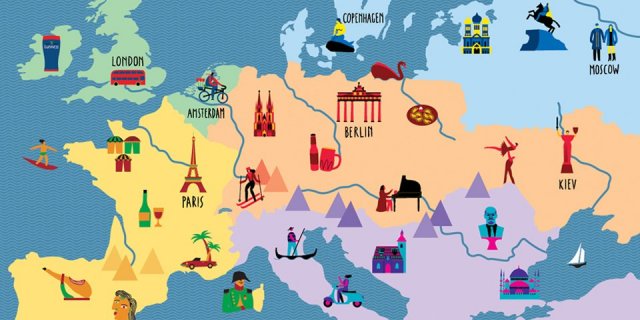
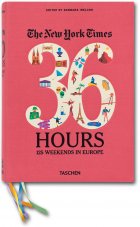
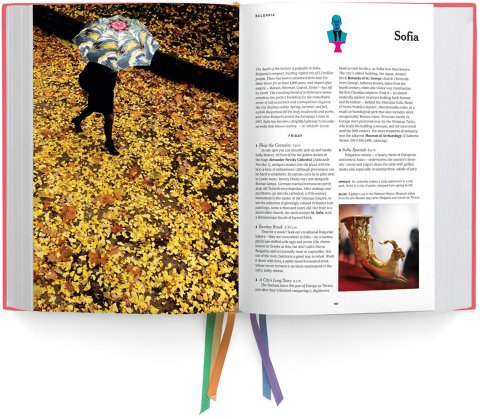









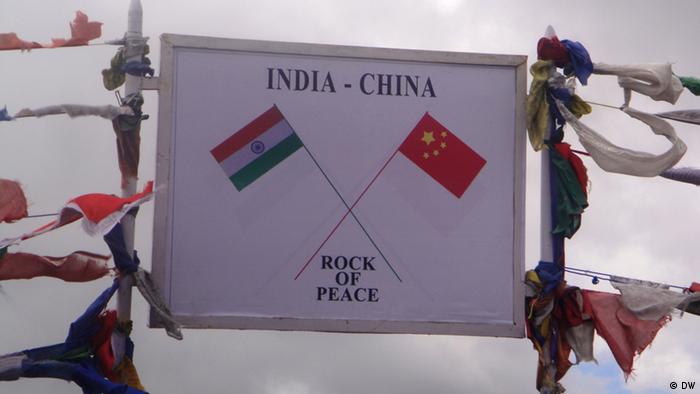
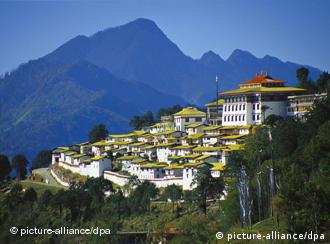 Tawang is quiet now, but maintains a large Indian troop presence
Tawang is quiet now, but maintains a large Indian troop presence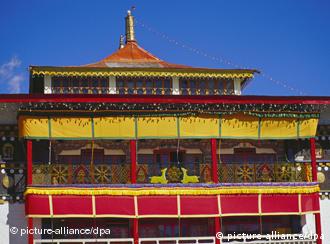 The Tawang monastery is a symbol of India's still smoldering border conflict with China
The Tawang monastery is a symbol of India's still smoldering border conflict with China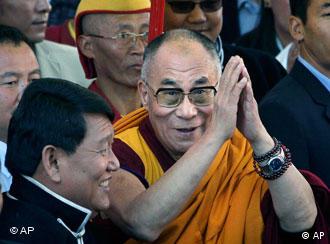 The Dalai Lama brushed off Chinese protests to visit Tawang
The Dalai Lama brushed off Chinese protests to visit Tawang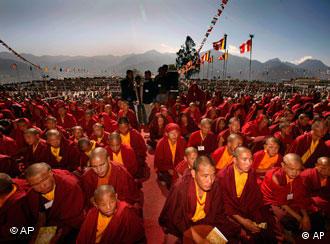 Thousands of Buddhist monks joined the Dalai Lama for prayers in Tawang
Thousands of Buddhist monks joined the Dalai Lama for prayers in Tawang



